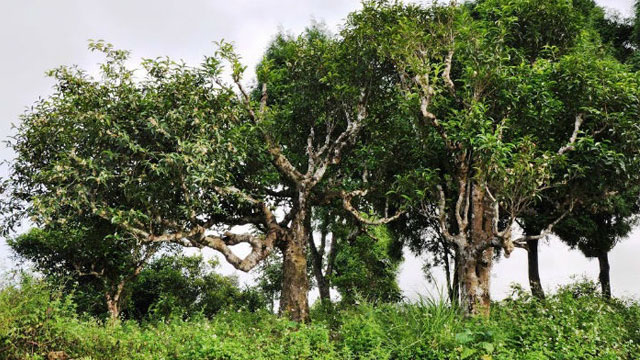Legend of the H’Mong people recounts that the time when heaven and earth were still undefined. One morning, a beautiful fairy descended from the earth and planted a strange seed in this land. The bigger the tree, the more lush the tree is with its spreading canopy, the leaves are almost half a hand large and the buds are filled with snow-white dew. One day a group of migrants came to meet an epidemic. Fortunately, thanks to the holy water from the leaves of this tree and spring water, the disease was cured. They named this strange place the stream of heaven, or Suoi Giang. Since then, people have been talking about this magical Shan Tuyet tea .
Today, Shan Tuyet tea is present everywhere, but only in Suoi Giang where there are many trees with hundreds of years old. The ancient tea trees from 100 -300 years old are impressive features that attract tourists every time they visit Suoi Giang. Each large tree branch stretched out to catch the sun and wind in the middle of the sky. The green buds covered with dew are anxiously waiting for the hand of the picker.
The image of the flower skirts hiding on the large, winding branches like a great picture makes visitors droop their legs and do not want to walk.
The older Shan Tuyet tea is, the more white it is covered, the more precious it is. Also because of this precious specialty, the processing must also be very careful. When tea stars have to master their hands so as not to lose white snow. When hunting with green peas applied to the outside of the pure white coat, the process is considered complete.
Shan Tuyet teapot smoky with iridescent golden water is also a careful selection of tea brewing. It must be an old terracotta kettle, the water from the mountain is boiling at the right temperature to bring a cup of Shan Tuyet tea with the right taste. Gently stir the thin smoke and then take a sip of tea to see the ethereal, sweet taste that lasts for hours without ever fading.
I don’t know if this leaf is as magical as the legend, but for those who have once visited, enjoyed tea and watched the ancient tea trees in the distance, it is already a great satisfaction.
Source: Collected internet.
Vietnam, whose national name is the Socialist Republic of Vietnam, is a socialist country located at the eastern tip of the Indochina peninsula in Southeast Asia, bordering Laos, Cambodia, China, and the sea. East and Gulf of Thailand. The territory of Vietnam has been inhabited since the Paleolithic era, starting with the states of Van Lang and Au Lac. Au Lac was annexed by the Trieu Dynasty in the North in the early 2nd century BC, followed by a period of Northern domination lasting more than a millennium. The independent monarchy was re-established after Ngo Quyen's victory over the Southern Han dynasty. This event paved the way for independent dynasties to succeed and then repeatedly win against wars of invasion from the North as well as gradually expanding to the south. The final period of Northern domination ended after the Lam Son insurgent army's victory over the Ming Dynasty.
Vietnam is located in the Indomalaya ecological region. According to the 2005 National Environmental Status Report, Vietnam is among the 25 countries with high levels of biodiversity, ranked 16th worldwide in terms of biodiversity and is home to about 16% of the world's biodiversity. species in the world. 15,986 plant species have been found throughout the country, of which 10% are endemic. Vietnam has 307 species of nematodes, 200 species of oligochaeta, 145 species of acarina, 113 species of springtails, 7,750 species of insects, 260 species of reptiles. , 120 species of amphibians, 840 species of birds and 310 species of mammals, of which 100 species of birds and 78 species of mammals are endemic. There are also 1,438 species of freshwater algae, accounting for 9.6% of the total number of algae species, as well as 794 species of aquatic invertebrates and 2,458 species of marine fish. In the late 1980s, a population of Javan Rhinos was discovered in Cat Tien National Park and it is possible that the last individual of this species in Vietnam died in 2010.
Vietnam's costumes are very diverse and rich, but the ones that impress people the most are the ao dai and the four-piece dress. The outfit carries the look and soul of Vietnam and when it comes to it, people will immediately think of Vietnam and that is the traditional ao dai. Traditional ao dai consists of a long shirt split into two front and back flaps, floor-length pants, material is silk or plain fabric, diverse colors and patterns.
Vietnam's history began from 1 to 2 thousand years BC. Over many centuries with the Ly, Tran, Le, and Nguyen dynasties, from the mid-19th century, Vietnam became a French colony. After the August Revolution, the Democratic Republic of Vietnam was born. The Battle of Dien Bien Phu in 1954 marked the end of the French in the territory, but Vietnam was divided into two countries: the Democratic Republic of Vietnam in the North and the Republic of Vietnam in the South. After the events of April 30, 1975, Vietnam was unified and from July 2, 1976, officially named the Socialist Republic of Vietnam.
